Cambodian New Year 2025: A Guide to Khmer New Year
I like celebrating New Year – the festivities, family gatherings, and the idea of a fresh start. In some parts of Asia, New Year is observed on a different date and with unique traditions.
I experienced it with the Balinese New Year, which as compared to Western celebrations – it’s a day of absolute silence.
Since then, I have looked forward to experiencing and learning more about other New Year celebrations in Asia.
In this post, I have collaborated with a local, Supraja Lakshmi N for a complete guide about the Cambodian New Year 2025. She’ll share how she celebrates with her family, plus insider tips!
Cambodian New Year is a three-day festival in April that marks the end of the harvest season and is a time for family gatherings, community celebrations, and religious rituals.
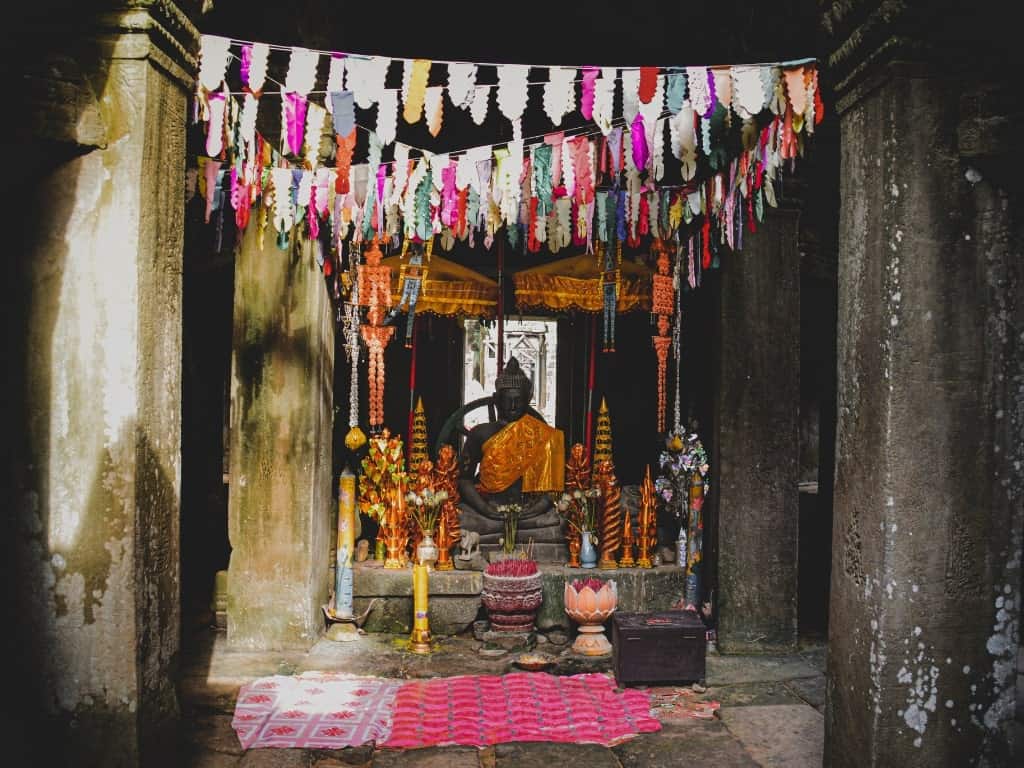
Cambodian New Year Celebration
Chaul Chnam Khmer (Khmer New Year), is a three-day festival starting around the 13th or 14th of April, depending on leap years, to celebrate the Cambodian New Year.
It is like Christmas, New Year, and birthdays all rolled into one, as everyone is out on the streets saying “Sus’Dei Chnam Thmei” (Happy New Year in Cambodian), and wishing each other, and their families success, peace, and happiness.
It is a very lively time if you are in Cambodia, as everyone is dressed up in their traditional outfit to make offerings at wats, cleaning out their homes, exchanging gifts, and just going wild with water and talcum powder.
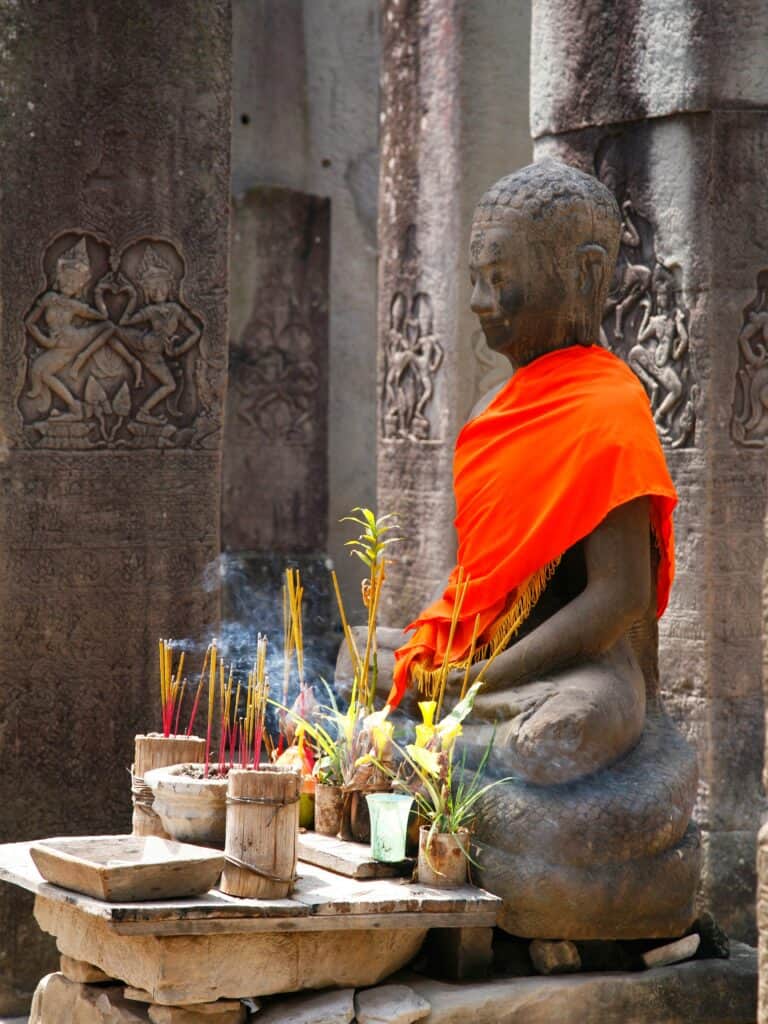
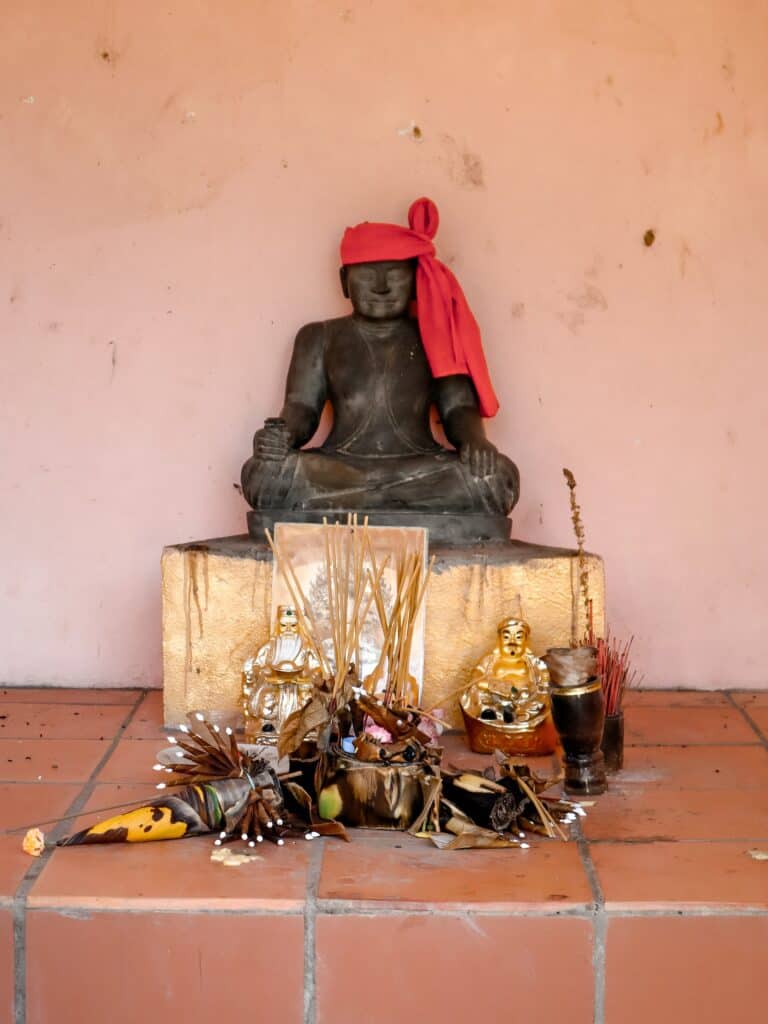
It’s fun to watch them go wild in the city of Phnom Penh, turning random expats into bemused-looking plaster-cast figures.
As expected, during this time, many Cambodians flock over to Angkor, so if you think it’s crowded during normal daytime hours at Angkor, you will be in for a shock. It is absolute madness during Chaul Chnam Khmer.
So, if you’re looking for a quiet, reflective, and meditative Angkor experience, it would be best to avoid booking hotels in Siem Reap or even going to Siem Reap altogether during this 3-day celebration.
However, cities, especially the capital Phnom Penh, are very quiet during the New Year celebration, as most people who live and work in Phnom Penh were not born there.
They come from other provinces, such as Battambang, Kampong Cham, Kompong Thom, Svay Rieng, Takeo, Siem Reap, and others. If you’re coming to Siem Reap, you’ll be happy to know it has several unique places to eat.
Khmer New Year 2025 dates
Khmer New Year 2025 will be celebrated from Monday, April 14 to Wednesday, April 16, 2025. The Cambodian New Year is celebrated for three days starting either on the 13th or 14th of April, depending on leap years.
Cambodian New Year 2025 Animal
The animal for Khmer New Year 2025 is the Snake, signifying a time for personal growth, introspection, and reevaluating goals.
Khmer New Year 2025 Angel
Each Cambodian New Year is believed to be overseen by one of the seven daughters of King Kabil Moha Prum.
These angels take turns in descending to Earth to bring blessings for the year ahead. The angel for each year is determined by the day of the week on which the New Year falls.
For the Cambodian New Year 2025, the presiding angel is Monday’s angel, “Kesor Mealy” or “Kesor Moni.” She is depicted riding a tiger and is associated with the moon.
Cambodian New Year History
Cambodian New Year is believed to have originated during the Angkorian era when Brahmanism, a form of Hinduism, was prevalent among the Khmer people.
Over time, Buddhism began to be associated with the festival and then became the basis for all the important rituals for the festival.
What is the legend of Khmer New Year?
Another legend also says that Khmer New Year was birthed from an angel’s descent to Earth, symbolizing the promise of happiness and good weather for a prosperous harvest in the year ahead.
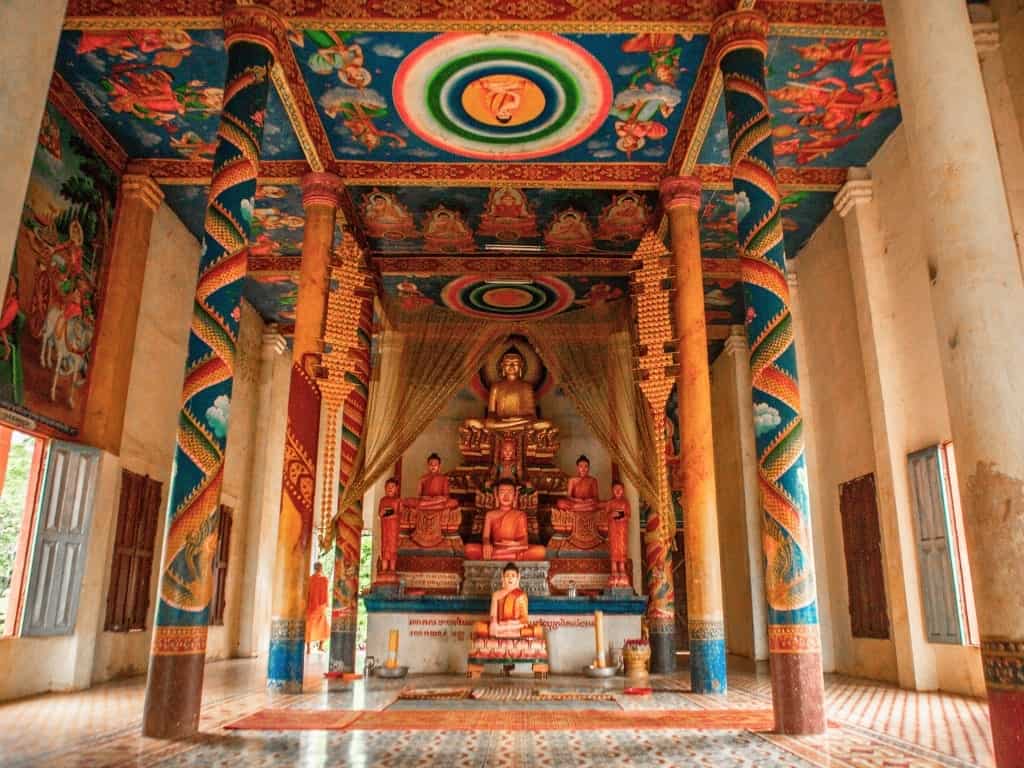
Why is the Cambodian New Year in April?
After the Angkor era, the lunar calendar was abandoned as the solar calendar gained popularity.
Therefore, one of the kings decided to change the New Year festival to April, to follow the solar calendar.
The main reason for the change was practical; people had more time to celebrate during the start of the rainy season.
Farmers had finished their fieldwork and harvested their crops, so they had more time to prepare for the festivities.
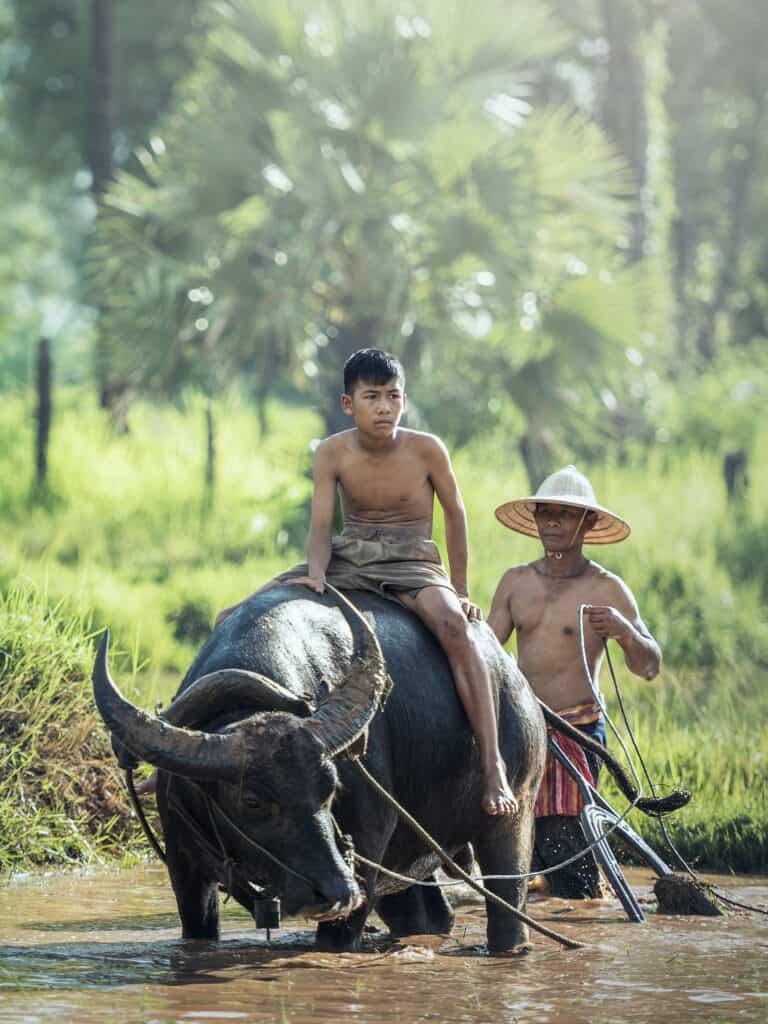
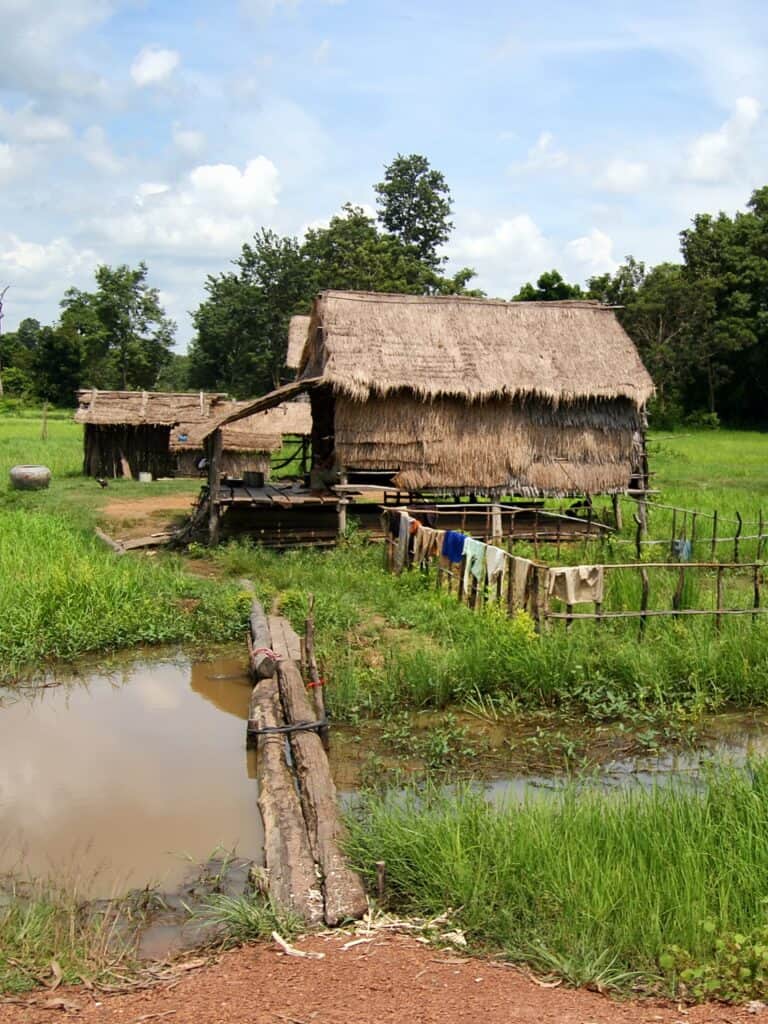
What are the 3 days of Khmer New Year 2025?
Cambodian New Year 2025 is celebrated for three days. Key rituals of the celebration include Buddha statue cleansing, prayers, and paying homage to ancestors.
Water also plays a significant role, with spirited water fights signifying the cleansing of past misfortunes and the ushering in of fresh hope and positivity.
First Day: Sankranti or Moha Songkran
On the first day of the Khmer New Year, known as “Moha Songkran,” a new deity or angel is chosen to safeguard the planet for the coming year.
One of seven angels is assigned every year depending on the day on which the New Year falls to protect the world for the coming year.
So, to welcome him, people would clean, decorate their houses, and dress appropriately to make sure that the New Year does not start with bad luck or unhappiness.
Each home prepares a traditional offering station to welcome the new god or angel individually by offering a table full of fruits, desserts with candles, incense sticks decorated with hand-ornated flowers, and flashing lights to ensure that the house and the family are protected for the rest of the year.
Cambodian traditional offerings usually consist of:
- A Buddha statue
- 5 incense sticks, and 5 candles
- 3 kinds of fruits, prepared into 2 trays
- A pair of decorated young banana tree
- Every offering is decorated with small jasmine flower braids
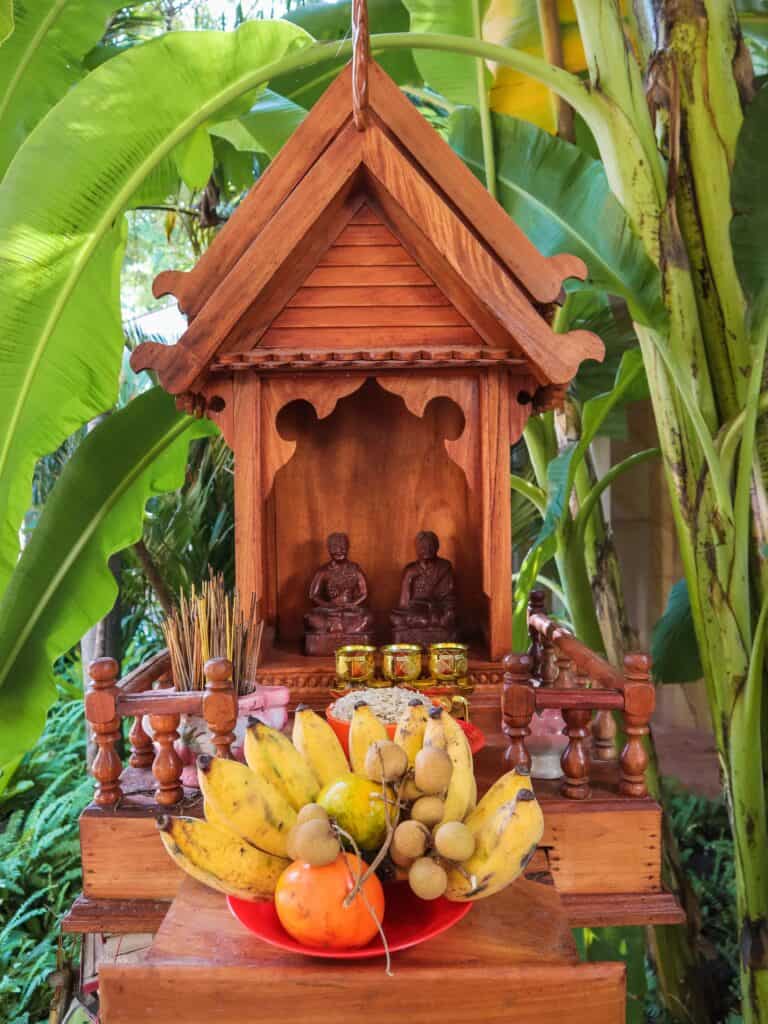
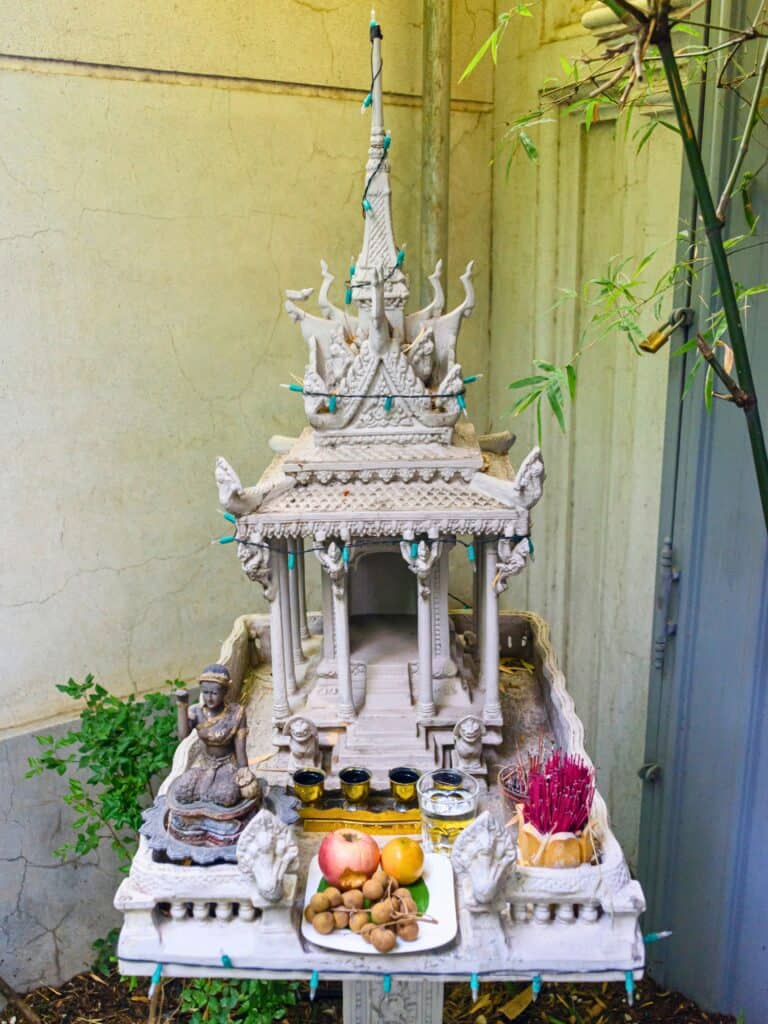
Cambodian parents are very conservative when it comes to the interactions with their daughters, but around New Year, it is the only time when young Cambodians are allowed to meet and engage in mixed play with the opposite gender, so many young men take this opportunity to look for potential brides.
That’s one of many Cambodian traditions. So, beware girls, if you’re a traveler and you notice the males are a little wild and frisky in comparison to other days.
Second Day: Virak Vanabat or Wanabat
The second day of the New Year is called “Wanabat”, the day of giving. As part of a tradition, gifts are usually given to your parents, grandparents, and the elderly to show your appreciation and love. In the evening, at the wat, monks chant to give blessings.
Cambodian New Year is very much a family celebration, so people who usually work far away from their families in other provinces would take a day off to come to celebrate with their families.
On the second day, Cambodian families gather at temples to remember their ancestors. They also donate money, food, and other things to the underprivileged based on what they can afford.
Various fun and traditional games are also held on the second day.
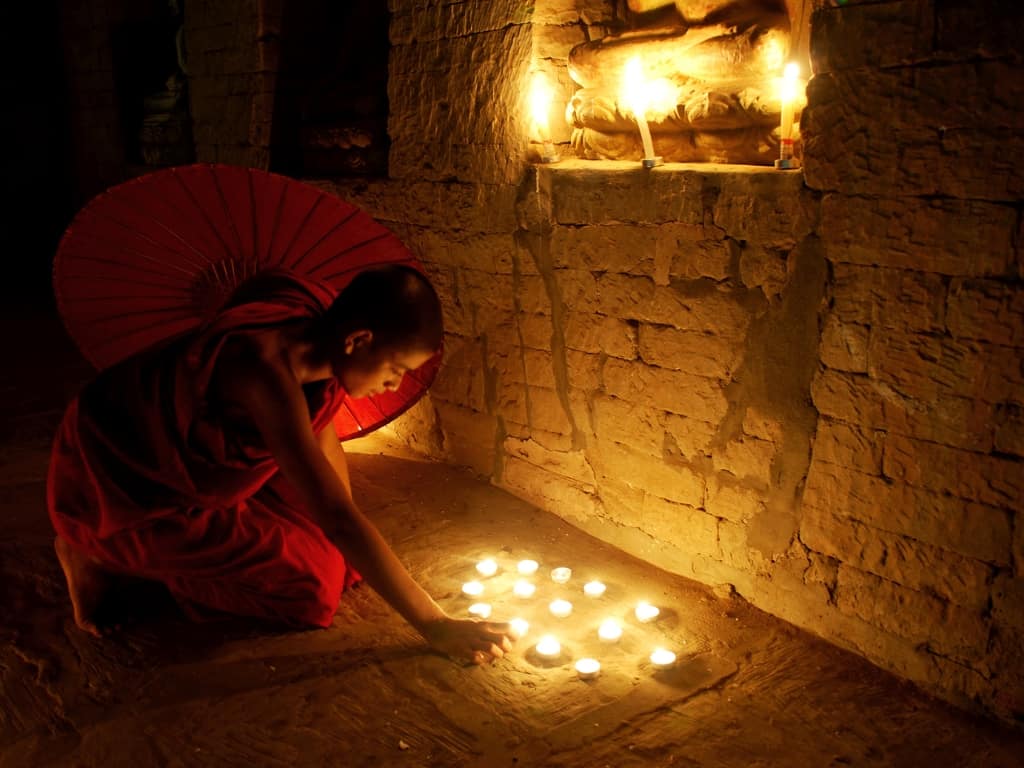
Third Day: Vearak Loeng Sak ot Tanai Lieang Saka
On the third day of the New Year, called “Tanai Lieang Saka”, a new beginning, we are once again at the wat, seeking the blessings of the monks, and lighting incense to wish prosperity and joy to families and friends on this new beginning.
We also use fragrant water to purify Buddha statues and their elders. This ceremonial act symbolizes cleansing away sorrow and sinful behaviors, just as clean water washes away dirt.
Washing our parents, grandparents, and elders brings blessings, joy, and a positive direction for the year ahead to us, children.
In the afternoon, a joyful farewell celebration is held in the streets, and in public places, people pour water on each other to wash away their “bap”, sins. Children and teenagers throw baby powder and flour at each other.
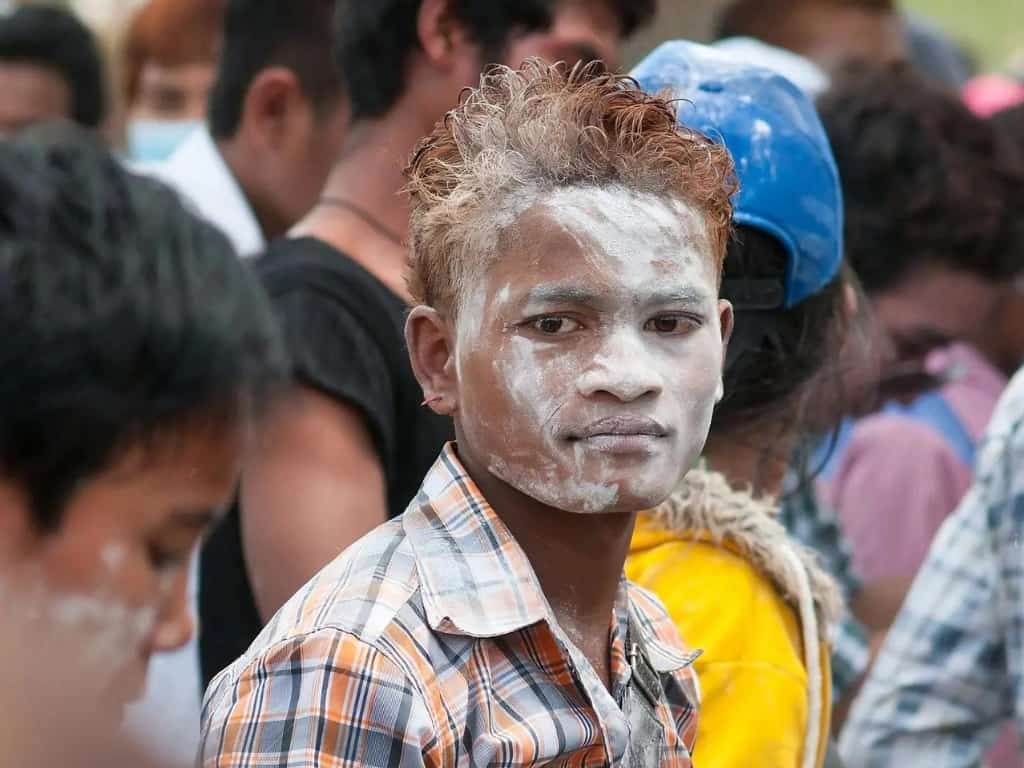
Khmer New Year Food
If you grew up in a Khmer household, it’s no secret that there’s always delicious food being served.
However, during the three days of Cambodian New Year, families take it up a notch, serving an impressive array of traditional dishes. These dishes are not only for the living but also a heartfelt offering to their ancestors.
Nom Ansom – a versatile dish that can be a sweet sticky rice dessert or savory made with bacon, nuts, and a salted egg filling.
Kralan – a steamed glutinous rice cake with coconut milk and nuts, packed inside bamboo pieces, and then steamed and roasted.
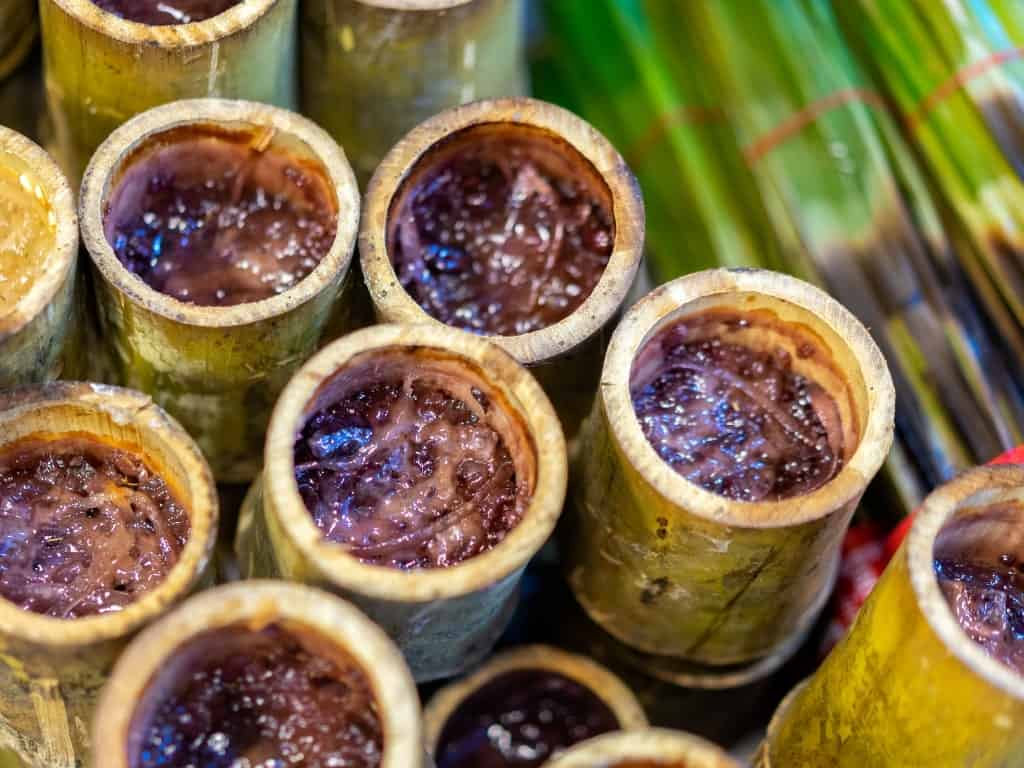
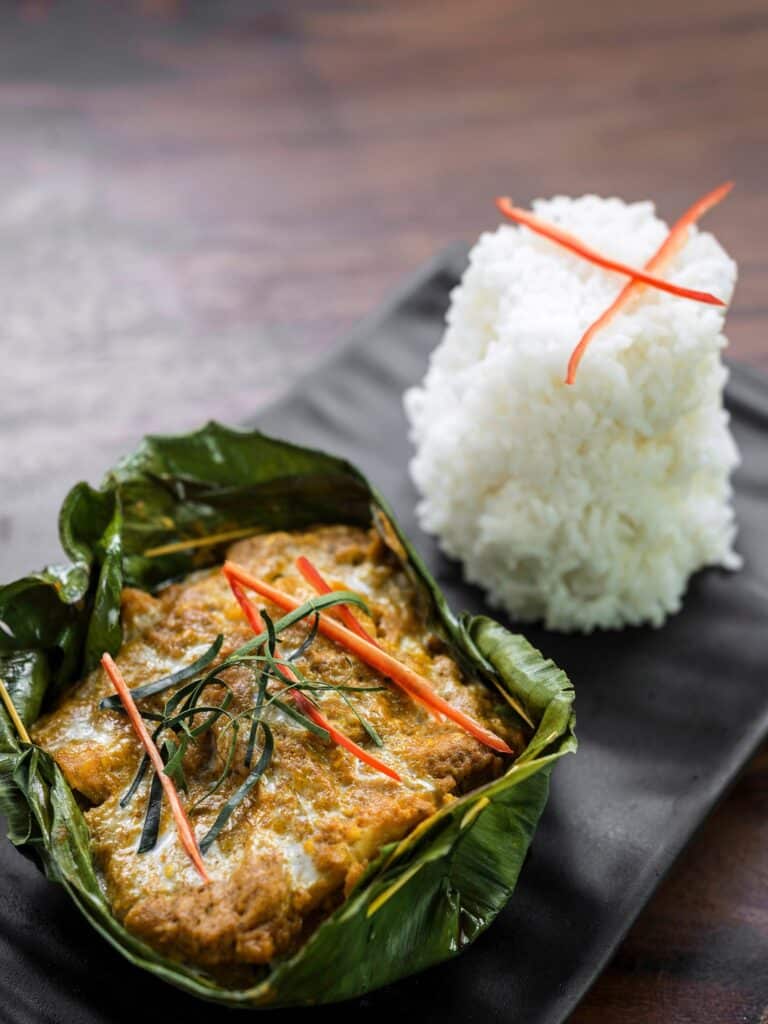
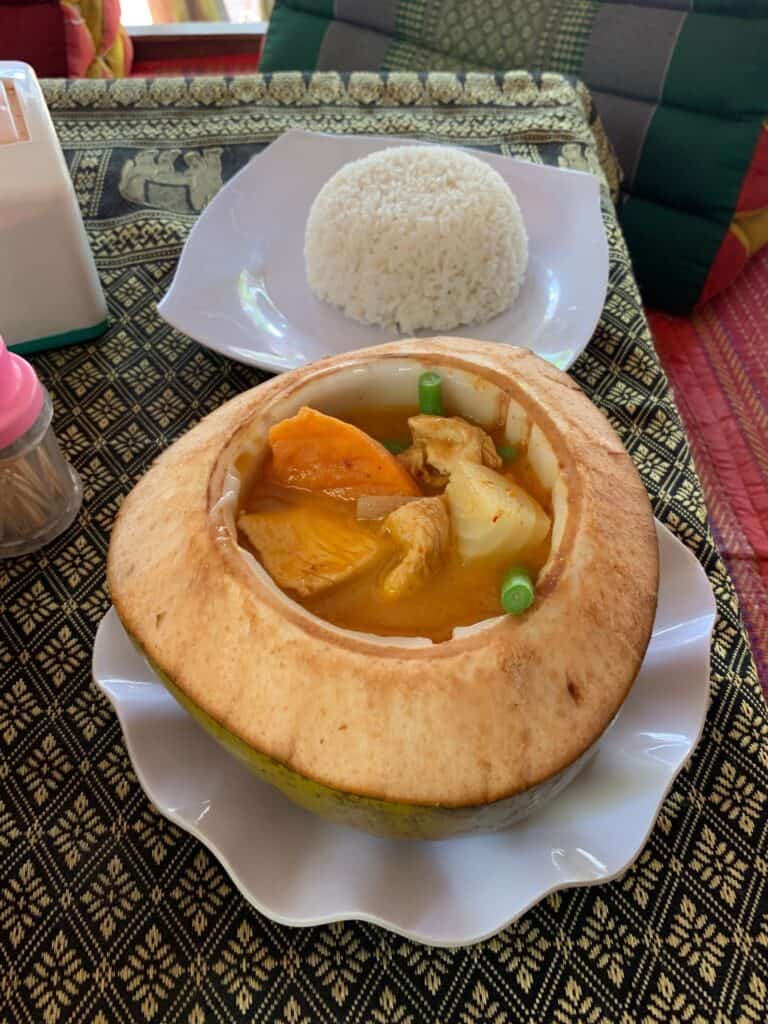
Khmer curry – a rich, aromatic curry made with coconut milk, chicken, potatoes, sweet potatoes, eggplants, green beans, and red curry paste called kroeung. It’s similar to Thai red curry, but not as spicy, rather a perfect balance of sweetness, spiciness, and richness.
Khmer Fish Amok – steamed fish curry with aromatic herbs, and coconut sauce resulting in a mousse-like consistency. It is considered one of Cambodia’s national dishes.
Ya Hon – is a savory hot pot that typically includes fresh ingredients like vegetables, meats, and noodles, all cooked at the table. It’s a heartwarming representation of shared moments and flavors during the Cambodian New Year.
Khmer New Year Traditional Games
Cambodian New Year 2025 is the time to watch the many traditional plays being showcased, to enjoy Khmer traditional dancing, rope pulling contests, and many other games with their family and friends. It’s a nice activity to add to your itinerary in Cambodia.
Traditionally, it is also the only time when young boys and girls are supposed to play together. It’s also a period when young men often look for potential brides.
Here are some of the Khmer Traditional Games:
Chol Chhoung involves two teams, one of the boys and one of the girls, who stand in rows opposite each other. A tied-up scarf, known as “chhoung,” is tossed between them.
When a player catches it, they quickly aim it at someone they like in the opposite row. If the Chhoung hits its target, that person leads their team in singing and dancing until it’s passed back to the other side, and the process repeats.
Ongkhun is a competition between two teams, where one team pushes their round, hard seeds called ongkhuns into the ground for targets. The other team attempts to hit these targets with their own ongkhuns.
The team that hits the most targets wins and has the opportunity to tap the knees of the losing team members, a rather painful consequence due to the hardness of the seeds.
Teagn Prot – Tug of War pits male and female teams against each other in an epic battle of strength. The goal is to pull the rope and the opposing team into their own playing field, and this game holds significant cultural value.
Bos Angkunh revolves around the nuts of the Angkunh tree. Two teams face each other and place Angkunh nuts on the ground in front of them.
Various formations are used, to outplay the opponent. The specifics of the game can vary, but it’s always a challenging and engaging competition.
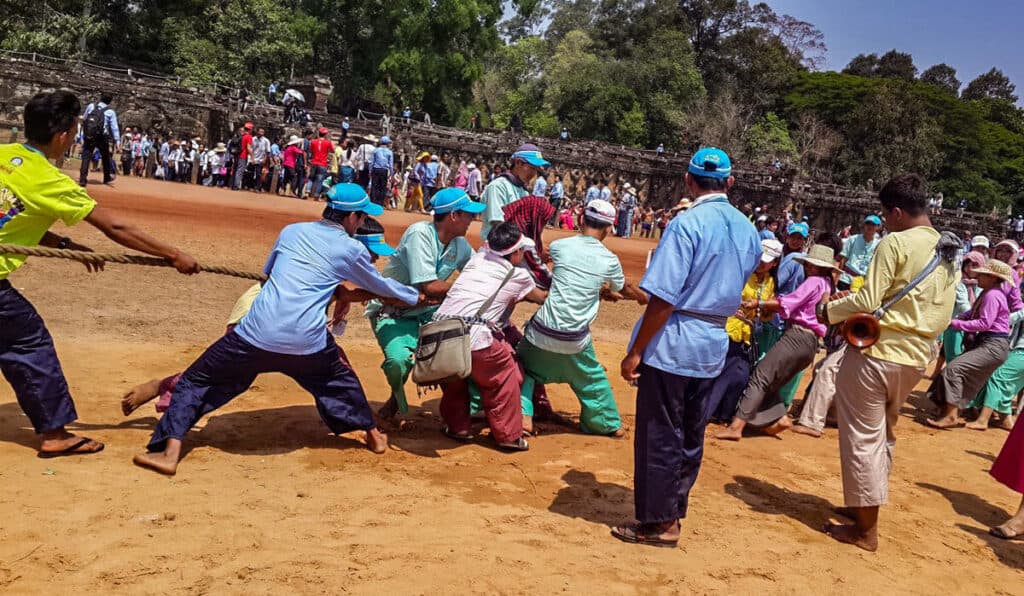
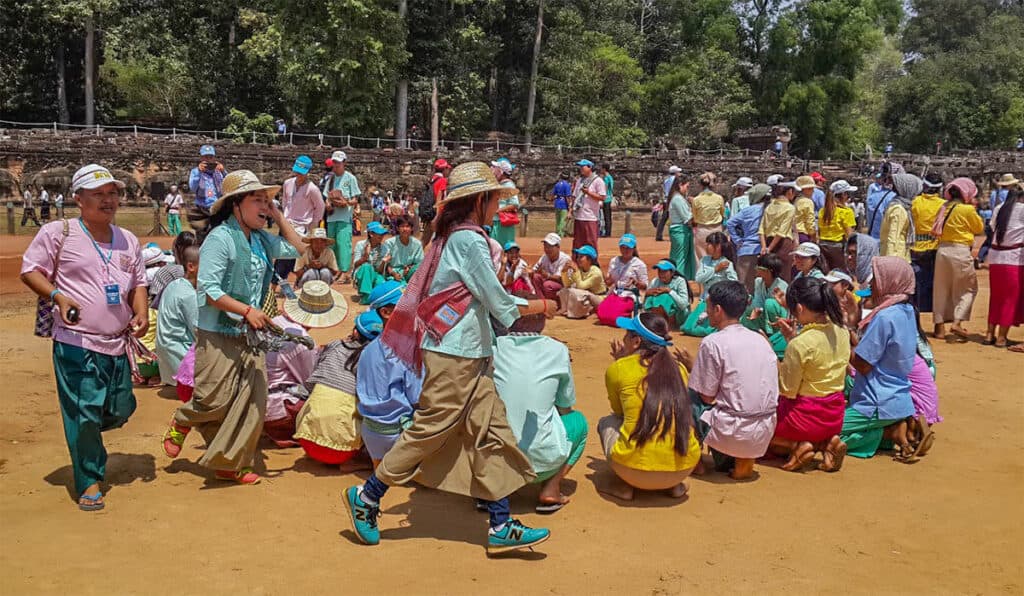
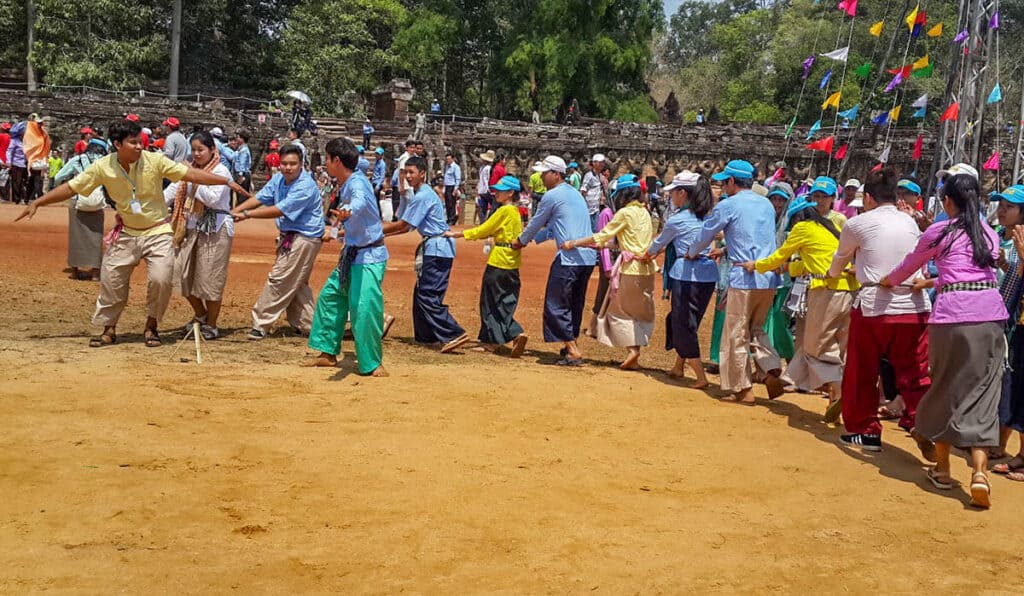
Chab Kon Kleng is a game played by adults, with one player mimicking a protective hen and another player emulating a crow.
The other participants act as chicks hiding behind the “hen,” and the “crow” tries to catch as many “chicks” as possible.
Leak Kanseng is a circle game where one player holds a “Kanseng” (Cambodian towel), walks around the circle, and sings.
While singing, the player secretly places the “Kanseng” behind one of the other players.
The player must then jump up and pursue the one who now holds the “Kanseng.” If they miss them, the game continues with the “Kanseng” passed to another player.
Bay Khom is a two-player game played in rural or urban areas. It involves ten holes in the shape of an oval dug into the ground. Small pearls, stones, or fruit seeds are used as game pieces.
The objective is strategically moving these pieces between holes, with the player who accumulates the most beads emerging as the winner.
Breaking Pot is a popular game where thin clay pots with flour and a small price (usually something sweet) are hung on a rope between trees.
The game aims to smash one of the pots with a stick while blindfolded. The player follows the direction of the screaming crowd and tries to find the right position to hit the pot.
If the player hits the pot, there is a flour “shower” while the others already collect the sweets from the ground.
What do you wear to Cambodian New Year 2025?
For Cambodian New Year, people often wear traditional Khmer clothing to honor their cultural heritage.
Men might wear silk shirts and formal trousers, while women might choose colorful silk blouses paired with sarongs or Sampot, a traditional Cambodian skirt.
The attire is usually bright and vibrant, reflecting the festive spirit of the New Year. Additionally, wearing new clothes is common on the first day of Khmer New Year to welcome the “angel” that comes on that day.
Dressing respectfully and embracing the local customs not only shows appreciation for Cambodian culture but also enhances the celebratory mood of the festivities.
Cambodian New Year Gifts
Traditionally, gifts are given to parents and elders on the second day of the Cambodian New Year. Children may also receive new clothes. This is also the time to donate money and used items to the poor.
If you’re coming to celebrate Cambodian New Year 2025 and give tokens of love, respect, and well-wishes for the coming year. Here are some common gifts:
- Fruit Baskets symbolize abundance and health. A beautifully arranged basket of tropical fruits is a popular and appreciated gift.
- Sweet Treats whether homemade or store-bought signify sweetness and joy in the New Year.
- Clothing: New clothes, especially traditional attire, are a common gift during Cambodian New Year because they represent renewal and prosperity.
FAQs: Cambodian New Year 2025
Do Cambodians celebrate Chinese New Year?
Yes. The Chinese inhabitants of Cambodia celebrate Chaul Chnam Chen (Chinese New Year) between late January and mid-February. Chinese New Year is usually celebrated for 23 days.
This is important when choosing a date for your Cambodia trip because many of Phnom Penh’s businesses are run by Chinese. Commerce stops during Chinese New Year’s Day, especially in Phnom Penh as there are dragon dances all over town.
Why is Cambodian New Year different?
Cambodian New Year, or Choul Chnam Thmey, is unique because it aligns with the Khmer solar calendar and marks the end of the harvest season and the beginning of the rainy season in mid-April.
This timing signifies renewal and is celebrated with traditional games, religious ceremonies, and community gatherings. It also reflects Cambodia’s rich cultural heritage and spiritual practices, setting it apart from other New Year celebrations.
What is the difference between Khmer and Cambodian?
The term “Khmer” refers to the ethnic majority and cultural heritage of Cambodia, closely linked to the ancient Khmer Empire and its traditions.
“Cambodian,” however, encompasses all citizens of the country, regardless of ethnic background, representing a national identity.
While “Khmer” highlights the country’s rich history and culture, “Cambodian” signifies the inclusive identity of its diverse population.
I love the reflective aspect of the New Year at the start of January. It’s a time to look back and see how many of the goals you set at the beginning of the year have been accomplished by the end.
But, I also love the light and playful Cambodian New Year; the family gathering, and especially, the food, food, and more food. Did you celebrate Cambodian New Year 2025? How was your experience?

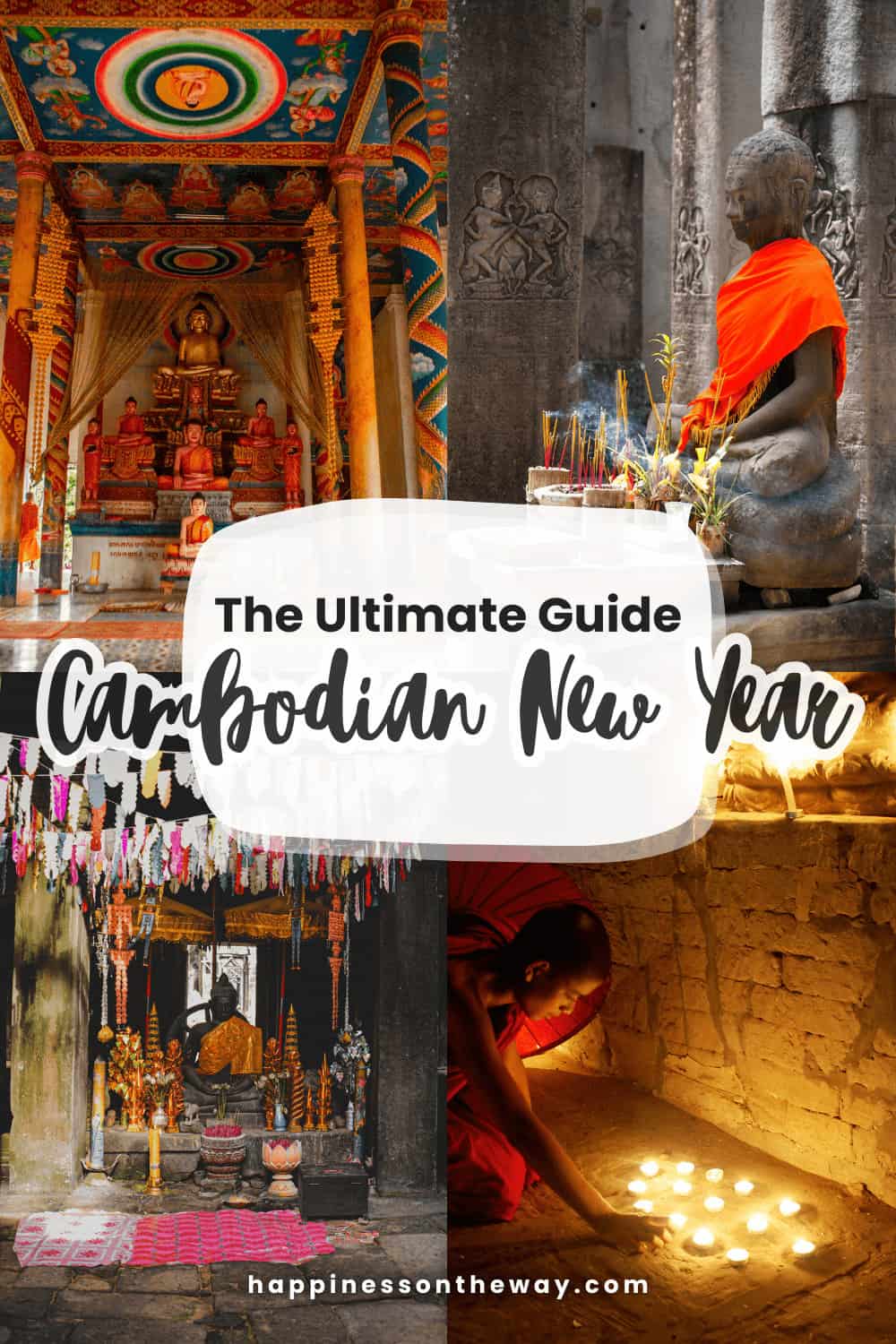

What a memorable thing to see. Would be great for me to visit Cambodia in April to experience the New Year festivities. I’ve only been to Cambodia once during June, but I was at Angkor Wat for the summer solstice sunrise so that was cool. It was just very hot haha.
I’ve never visited Cambodia before but it sounds like an amazing place to experience New Year Festivities. Thanks for sharing this!
Cambodia is truly beautiful, with its iconic Angkor Wat and much more beyond!